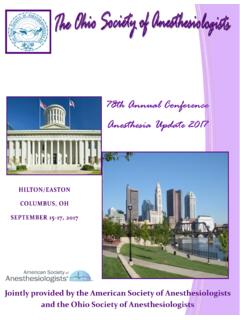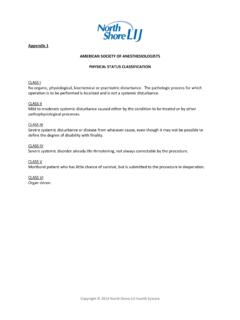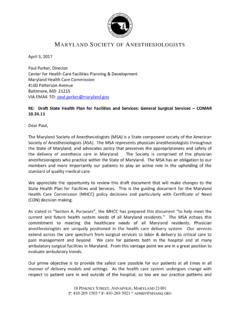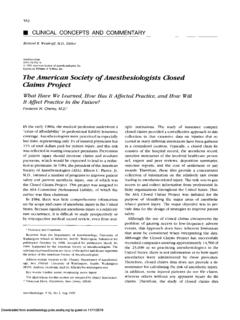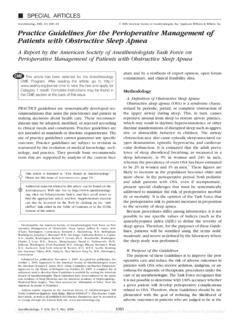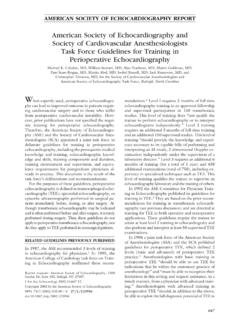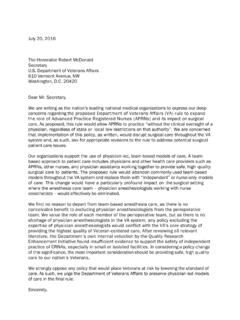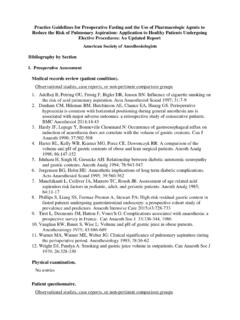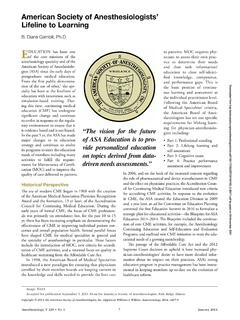Transcription of Parameters of Care American Society of Dentist ...
1 PARAiWETERS OF American Society of Dentist Anesthesiologists: Parameters of Care The Society of Dentist Anesthesiologists' . (ASDA) Parameters of Care describe the range of appropriate anesthetic practices by Dentist ane::.thesiolo-gists practicing in the United Since anesthesiol-ogy is the practice of dentistry, these Parameters of Care include standards, guidelines, and management strategies ki assist Dentist anesthesiologists in the safety and comfort of patients while risk and discomfort. Individuals with expertise and broad, in-depth, clinical experience in the wide variety of anesthesia practice venues used in dentistry prepared these practice Parameters . Conclusions were derived based on review of the scientific literature, various standards and guidelines, as well as Parameters of care of other major anesthesia provider organizations, The ASDA believes these pa-rameters broaden the range of practices to include the professional judgment of the practitioner.
2 Given the dynamic nature of anesthesia practice within dentistry, these Parameters of Care wm be updated as needed to reflect advancements in the art and science of ane.'ithesia, While these Parameters of Care are designed to assist the Dentist anestbesiologi~t in determining the most appropriate anesthetic care options, the ultimate deci-sion regarding treatment of an individual patient lies with the provider based on the specific clinical circum-stances. Furthermore, adherence to these Parameters does not guarantee a successful clinical outcome, When circumstances require a deviation from these Parame ters, the provider is advised to indicate in the clinical record the circumstances and rationale for the deviation. THE CONTINUUM OJ,' SEJ)ATION ANil ;IA Sedation and anesthesia comprise a continuum of peripheral and central nervous system depression rangiug from local anesthesia through various levels of sedation to general anesthesia.
3 The ASDA Parameters of Care support the definitions of local anesthesia, minimal sedation, moderate sedation, deep sedation, and general anesthesia as defined in the American Dental Associa-i Any variation from docum,mt related to an<.'sthe sioiogists practicing in Canada will be deferred to the published Canadian provincial standards of practice. Anesth I:'rog 65:197-203 20! 8 t DOI 1U,2344/anpr 65-03 i9 2018 by the American Dental Society of Atl'.!!lthesiology 197 tion's (ADA) Guidelines for the Use of Sedation and General Anesthesia by Dentists. Because Dentist . anesthe-siologists are trained to competency, as outlined in their comprehensive residency accreditation standards, in all levels of sedation and general anesthesia for very young children through adulthood, Dentist intending to produce a given level of sedation can diagnose and ma11age the physiologic consequences for patients whose level of 1.,edation becomes deeper than initially intended.
4 If appropriate, Dentist anesthesiolo-gists may convert the level of sedation to either deep sedation or general anesthesia or otherwise altet the level of sedation or general anesthesia. as needed based on patient and surgical neoos. DEFL.~ITIONS1 Analgesia: The diminution or elimination of pain. Local anesthesia: The eliminatlon of sensation, especially pain, in one part of the body by the topical application or regional injection of a drug. Minimal sedation: A minimally depressed level of consciousness prnduccd by a phannacological method that retains the patient's ability to independently and continuously maintain an airway and respond nonnally to tactile stimulation and verbal command. Although cogni-tive function and cot1rdination may be modestly impairoo, ventilatory and cardiovascular functions are unaffected. Moderate sedation: A depression of consciousness during which patients respond purpose-fully to verbal commands, either alone or accompanied by light tactile stimulation, No interventions are required to maintain a patent airway.
5 And spontaneous ventilation is adequate. Cardiovascular function is usually maintained, Further, a patient whose only response is reflex: withdrawal from a painful stimulus is not considered to be in a state of moderate sedation. Deep sedation: A drug-induced depression of con-sciousness during which patients cannot be easily aroused but respond purposefully following repeated or painful stimulation. The to independently maintain ventilatory function may be impaired. Patients may require assistance in maintaining a patent airway, 2 The definitions are e;1:cerpts from the AD A's Jo, the of Sedaliori arid General Am1nhe,r{a f:!; Dentfsls. _ ASDA Parameters of Care and spontaneous ventilation may be inadequate. Car~ diovascular function is usually maintained. General anesthesia: A drug-induced loss of conscious-ness during which patients are not arousable, even by painful stimulation. The ability to independently main-tain ventilatory function is often impaired.}
6 Patients often require assistance in maintaining a patent airway, and positive pressure ventilation may be required because of depressed spontaneous ventilation or drug-induced depression of neuromuscular function. Cardio-vascular function may be impaired. Standards: Clinical practices that are to be applied in all cases. Deviation from standards would be djfficult to justify. A standard of care indicates that mcasurahle criteria are present, and these criteria shall be used to arri-re at a given level of outcome. Gujdclim:.--s: Clinical practices that should be followed in most cases, with the realization that treatment may be tailored to fit individual needs, depending ou the , setting, and other factors. Deviations from guidelines may be justified by differences in individual drcurru,tances. Protocols; Descriptions of the proces.<.: of care for individual patients. Must/shall: Indicates an imperative need and/or duty; an essential or indispensable item; mandatory.
7 Should: Indicates the recommended manner to obtain the standard; highly desirable. May; Indicates freedom liberty to follow a reasonable alternative. Dentist anesthesiologist : A Dentist who has success-fully completed an accredited postdoctoral anesthesiol~ ogy resldency training program for dentists in accord with Commission on Dental Accreditation (CODA) Standards for Dental Anesthesiology Residency Pro-grams, qualifying to administer all levels of the continuum of sedation and anesthesia care within the scope of their dental license. 3 VENUES JfOR ;;THESIA DELIVER\' Sedation and general anesthesia can be safely delivered in a variety of venues, Hospital operating rooms, ambulatory surgery centers, and dental offices vary widely in size and complexity, hut all anesthetic practices, whether fixed in one or more locations or ~ Dentists who completed an anesthe~io!ogy residency prior to CODA ac~,mlitation of their program, but iu accordance with CODA standards or the previous standards of the American Dental Association's Guidelines for Teaching thE Comprchensi1 e Cotmol of Pain and An.
8 :deiy in DeMWry, Pan 11, in effect at the beginning of their prc.,grnm, are aisl qualified as Dentist anesthesfologists it they met eligibility requiremenis for examination by the American Dental Board of Anesthesiology, 198 Ane.~th Prog 6SJ97--203 2018 mobile and transferred to multiple venues, must provide adequate anesthetic equipment, monitors, and medica-tions for lhe safe conduct of the anesthetic plan and for successful management of emergencies that might arise. The ASDA endorses the ADA's Guidelines for Sedation and General Anesthesia by as minimum standards for determining the adequacy of any office venue as an anesthetizing location, whether fixed iu only one office, in several satel1ite offices, or in the multiple offices that mohile Dentist transform into a fully equipped anesthetizing facility. The ASDA does not object if state boards determine it is necessary to evaluate the sedation and general anesthesia practitioner practice systems and competen(.)
9 ~ in providing sedation and/or general anesthesia at initial Hcensure and periodically as required. The actual evaluation by a dental board or a recognized national accrediting organization can be at either the fixed office location of a Dentist anesthesiologist 's practice or, in the case of a mobile anesthesia practice, at any one location where the mobile Dentist anesthesiologist provides servic~ es. It is the quality of the mobile anesthesia practitioner and practice systems that should be evaluated for patient safety, irrespective of the actual physical location. The Dentist anesthesiologist must ensure that all facilities where sedation and/or general anesthesia is provided, whether at the primary location, a satellite location or at multiple locations, are held to the same standard of excellence, are comparably equipped with anesthetic emergency drugs and equipment, and that the operating Dentist and/or auxiliary staff are adequately trained to assist the Dentist anesthesiologist with,basic life support resuscitation if needed so the Dentist anesthesiologist can administer advanced resuscitation.
10 For Dentist anesthesi ologi<:ts who have a mobile anesthetic practice, state inspectiou or national accreditation of the facility must take place only when the Dentist anesthesiologist is present So long as the mobile Dentist anesthesiologist has all the necessary drugs, monitors, and anesthesia equipment in a facility at the time of patient treatment, there is no need to have these drugs present or permanently installed monitors and anesthesia equipment at that facility when the Dentist anesthesiologist is not in attendance. Once a Dentist anesthesiologist has undergone a successful evaluation of their anesthesia practice system within their mobile anesthesia facility in one location, there is no need to undergo subsequent evaluations of that anesthesia practice system within the same mobile facility in other offices or facilities where the Dentist anesthesiologist intends to provide services. When the Dentist anesthesiologist is in the office of another practitioner to provide the anesthesia, monitor the patient.
